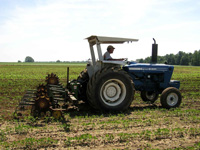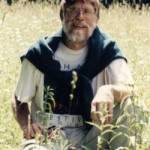In my position of field assistant this summer, I have been working on two different projects. One has been underway for several years and is looking into the ecological as well as economic impacts of different cropping systems (for vegetable and field crops). The other looks more into the effects of fertilizers on weed competition. The latter project is in its first year and is under the direction of a graduate student. I will use this post to describe the research work I have been participating in this summer.
The organic cropping rotations project is being done on two different sites- the Vegetable Crop Research Farm in Freeville, NY and the Musgrave Research Farm outside of Aurora, NY. Both are Cornell facilities and at Musgrave, we have our field crop plots.
At the Musgrave Farm, we have 4 replicates of 5 different treatments to the same field crop rotation. The rotation is soybeans to winter spelt under-sown with clover to corn (a three year rotation). Each year, there are two entry points and so this year, we grew the winter spelt/clover and corn. Next year will have corn and soybeans.
The five systems of the plots at Musgrave represent different management practices for inputs of fertilizer and tillage. In System (1), we use the recommended nutrient application rates for conventional management and normal tillage practices to control the weeds. Of course, for fertilizer, we use composted manure to follow organic management practices. System (2) aims to have lowered inputs both for nutrients and labor (cultivation) in order to maximize profitability. (3) has the intensive weed management i.e. more cultivation to remove any unwanted weeds and normal fertilizer rates. This system tends to be the most laborious. System (4) has reduced tillage with normal fertilizer application. The system 4 plots tend to be the hardest to collect data from because of the constant fight with weeds. The last system, (5), is the straight conventional plot where we use a conventional chemical fertilizer and use a early season herbicide on the plots. We use this plot to mark to the performance of the organic plots against the conventional system. System five needs to be a certain distance away from the organic plots under organic law so there is a buffer zone in between these systems.
Throughout the season, we are collecting data on all of these systems for weed and pest counts and identification, nutrient and biomass yields, as well as the profitability of the system.
At the Freeville research farm, we examine similar aspects but in a slightly different manner because we are working with vegetable crops. Here, there are only 4 different system types and each are on a 4-year rotation. The systems differ on the intensity of the land use again but with a slightly different spin.
I will list the 4 system types here:
(1) An intensive system with high inputs of fertilizer, no legume cover crops, and we harvest 6 cash crops in the 4 year rotation.
(2) This system has an intermediate intensiveness with a low fertilizer application, heavy legume cover crop integration, and 4 cash crops harvested in the 4 years.
(3) An “extensive” system whereas there is a low fertilizer application, heavy in legume cover crops, and only two cash crops taken off in the 4 year rotation.
(4) The last system uses a ridge tillage technique to cultivate the plot with the same input/output levels as the intermediate system. This style of conservation tillage can be productive but tends to not work in our test plots and is very evident at juxtaposition.
The fertilizer used in these organic test plots are a compost and this year we used compost from the Cornell industrial composting facility.
The four vegetable cash crops used in this study are winter squash, fall cabbage, lettuce, and potatoes. A great benefit to working this position is that there is an unlimited supply of these vegetables come harvest time.
The majority of my work surrounding this project has been collecting data on these plots. We have collected data on growth of the crop, identification and sometimes weight of weed biomass, time of hoeing, pest occurrence, and nutrient sampling of crops and weeds. The data we collect will give us a picture of nutrient input and output as well as the agro-ecology of the test plots.
The other project I have been working on this summer that is under the direction of a Cornell graduate students looks into nutrient’s role in weed competition. It is a very interesting topic and has been a lot of work for her getting it going.
The main reason for the mass of work involved with this project is the set up. With five species under examination, partitioning N/P/K, at 4 different application rates, and with 3 repetitions; there are 330 different testing stages that we most go through for every activity. With this number, any activity is quite the tedious job. To work for science tends to be quite tedious and I have been able to form my own interests in research work through this.
The project’s purpose is to find the point where crops max out their own utilization of the nutrients applied and weeds continue to use the nutrient stores in the soil to increase biomass. This research would help out organic farmers with the decision in the amount of fertilizer to apply. The project partitions NPK into the individual nutrients and simulates the amounts of that nutrient at varying levels composted manure applied.
The setup of the project is sort of quirky and, as I said, has been a lot of work doing. In order to separate each of the 330 experiments into their own, isolated area, we have built 330 square boxes of wood to put in the ground 330 times and filled with an amended soil 330 times. This doesn’t include planting and thinning 330 boxes of plants and measuring 330 different boxes of plants for growth data. It has been quite exhausting but fun when you work with the fun group that I had this past summer.
The experiment uses two crops and three different but common weed species. The partitioning of the nutrients from composted manure are in the form of Bone Char for phosphorous; blood mean for nitrogen; and potassium sulfate for potassium. The amount of these nutrients are derived from the amounts that would naturally be found in composted manure. So then we even differentiate the amounts amended to the soil in the boxes by the relative lbs/acre of N. These rates are 40, 80, 160, and 320 lbs/ acre of N.
This project looks into a really interesting concept for agriculture and I feel that I a lot can be learned from this study. One thing that I have already picked up from this experiment is the monotony of research work. This eludes to a major theme that I have uncovered from this summer’s work. That academic research work is very important for education and progress but also that I may not choose it exclusively as a profession.




